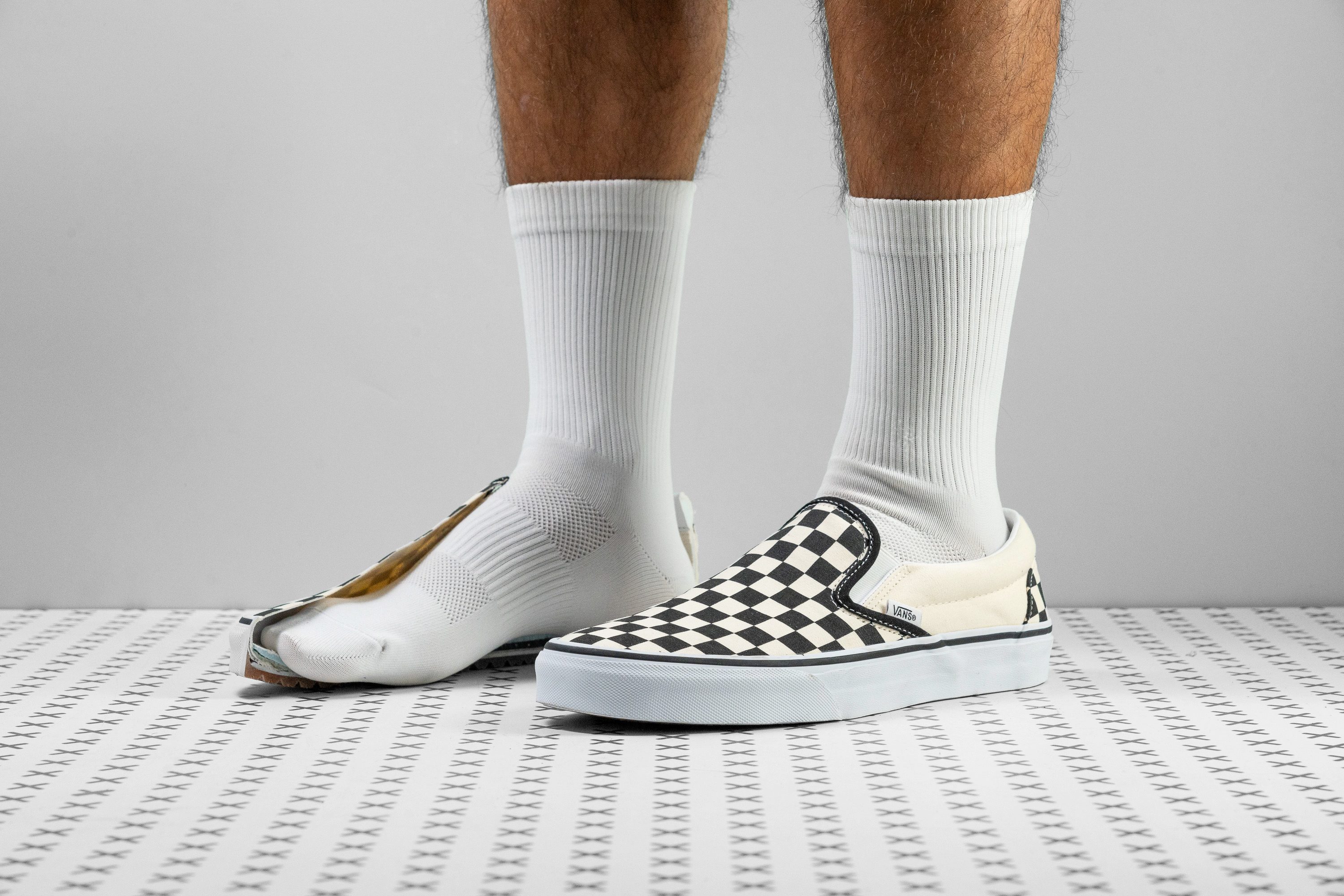Our verdict
- Top pick in best canvas sneakers
Pros
- Extremely comfortable
- Easy on and off
- Timeless style
- Clean and versatile
- Durable
- Compliment magnet
- Time-tested quality
- Pocket-friendly range
Cons
- Poor ventilation
- Stiff at first
- Low midfoot volume
Audience verdict
- Top 28% in Vans sneakers
- Top 30% in winter sneakers
Comparison
The most similar sneakers compared
+ + Add a shoe | |||||
|---|---|---|---|---|---|
| Audience score | 92 Great! | 91 Great! | 94 Superb! | 89 Good! | |
| Price | $50 | $90 | $80 | $75 | |
| Style | ClassicMinimalist | Business casualRetroSportyMinimalist | Sporty | ClassicSporty | |
| Shock absorption | - | Low | Low | Low | |
| Energy return | - | High | Moderate | Low | |
| Traction | - | Moderate | Moderate | Low | |
| Breathability | Warm | Warm | Moderate | Breathable | |
| Weight lab | 14.1 oz / 400g | 11.3 oz / 319g | 11.7 oz / 332g | 16.5 oz / 468g | |
| Size | True to size | True to size | Slightly small | True to size | |
| Midsole softness | - | - | - | Firm | |
| Material | CanvasVulc Sole | Gum SoleLeatherSuede | Cup SoleSuede | SuedeVulc Sole | |
| Season | Winter | Winter | SpringFall | SpringFall | |
| Inspired from | Skate | Tennis | Skate | Skate | |
| Width / fit | Wide | Narrow | Medium | Wide | |
| Toebox width | Medium | Medium | Medium | Medium | |
| Leather/suede quality | Fake leather | Real leather | Real suede | Real suede | |
| Toebox durability | Decent | Decent | Decent | Good | |
| Heel padding durability | Decent | Good | Decent | Good | |
| Outsole durability | Bad | Decent | Good | Decent | |
| Heel stack lab | 18.7 mm | 16.9 mm | 17.6 mm | 18.2 mm | |
| Stiffness | Moderate | Flexible | Flexible | Flexible | |
| Tongue padding | Very thin | Thin | Average | Very thick | |
| Drop lab | 6.7 mm | 4.6 mm | 7.0 mm | 7.6 mm | |
| Forefoot | 12.0 mm | 12.3 mm | 10.6 mm | 10.6 mm | |
| Removable insole | ✗ | ✓ | ✓ | ✗ | |
| Heel tab | None | None | None | Finger loop | |
| Torsional rigidity | Flexible | Flexible | Flexible | Flexible | |
| Heel counter stiffness | Flexible | Flexible | Moderate | Moderate | |
| Closure | Slip-on | Laces | Laces | Laces | |
| Top | Low top | Low top | Low top | Low top | |
| Ranking | #40 Top 34% | #52 Top 43% | #18 Top 15% | #85 Bottom 29% | |
| Popularity | #60 Top 50% | #23 Top 20% | #56 Top 47% | #11 Top 10% |
Who should buy
We think that the Vans Slip-On will make an excellent addition to anyone’s shoe rotation, especially:
- Those in the market for a minimalist, all-rounder of a shoe that’s suitable for street strolls or skateboarding sessions
- Sneaker fans looking for a timeless design that can be paired with almost any attire
- Anyone looking for a shoe that’s easy to slip into that’s comfy enough for a quick trip to the shops, walking the dog, or even all-day use
- Rebels with punk rock pumping through their veins looking for a shoe that fits the skater aesthetic
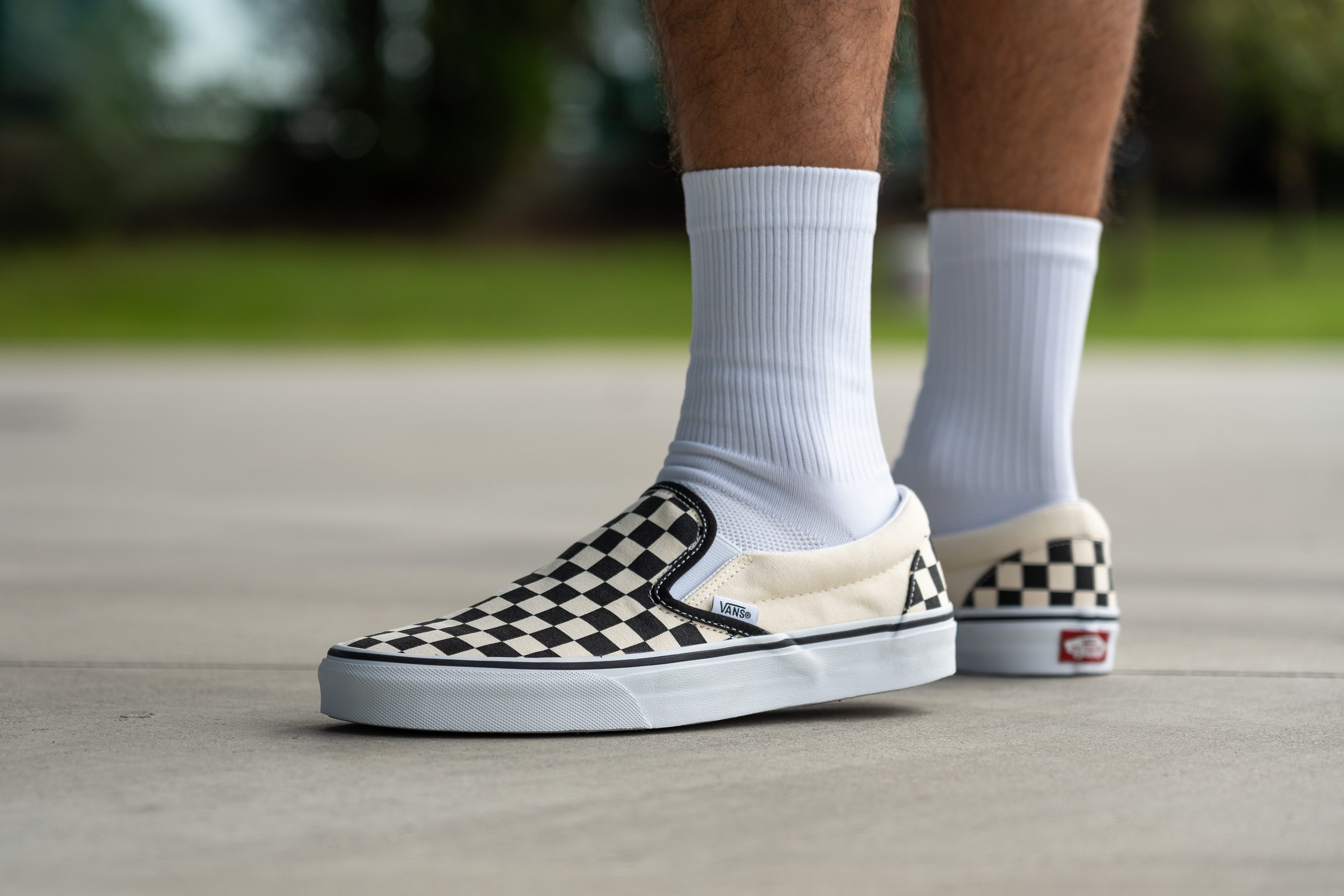
Who should NOT buy
With its narrow toebox, the Slip-On isn’t the best choice for those with broad feet. Instead, check out the New Balance 574 as a roomier alternative.
The Slip-On’s breathability leaves much to be desired, so going sockless in such a poorly ventilated shoe is a surefire recipe for sweaty/stinky feet. The New Balance 327 is a much more well-ventilated option that will keep the feet fresh even on hot summer days.
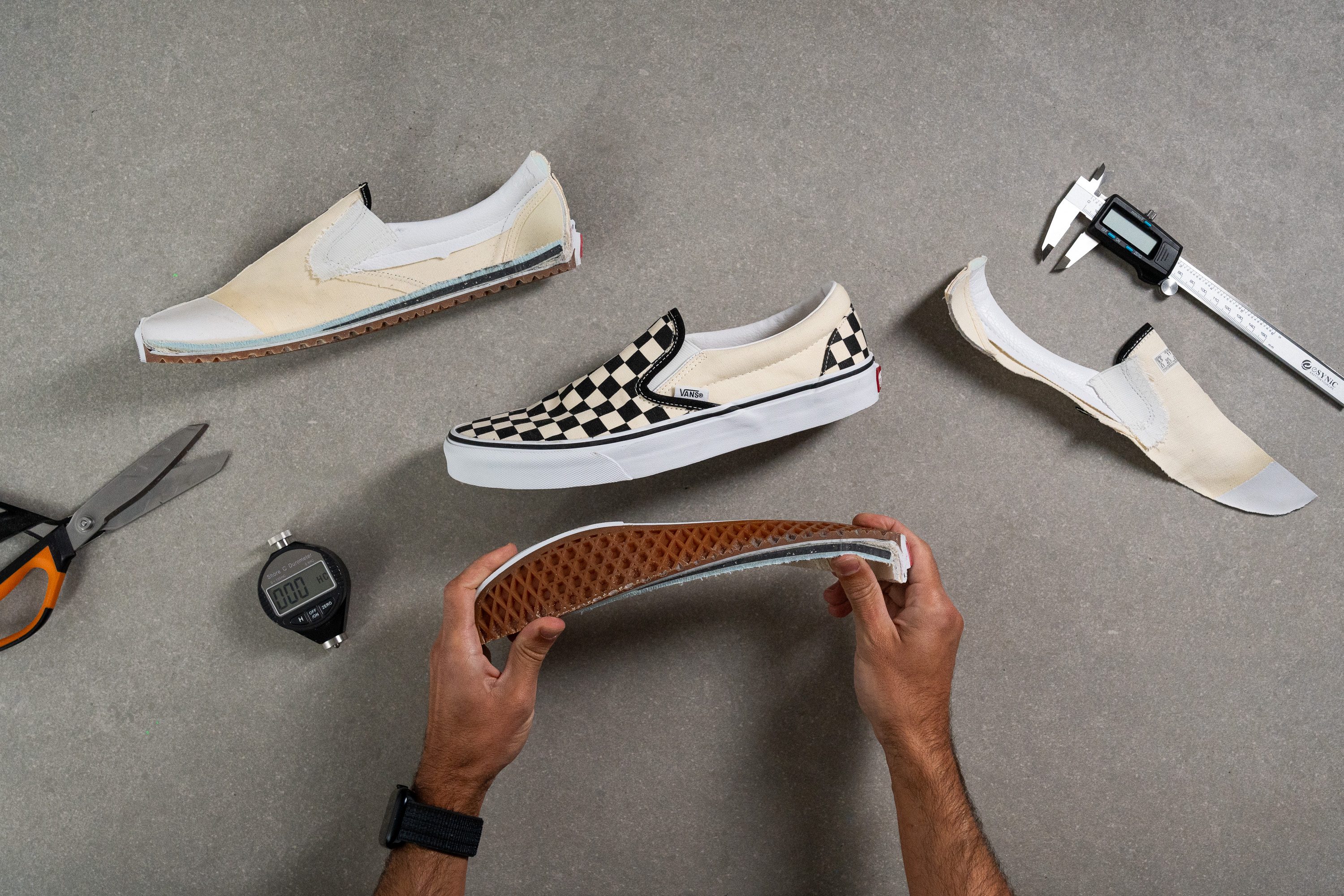
Cushioning
Heel stack
We measured the Slip-On’s stack at only 18.7 mm, making it significantly shorter than our current lab average.
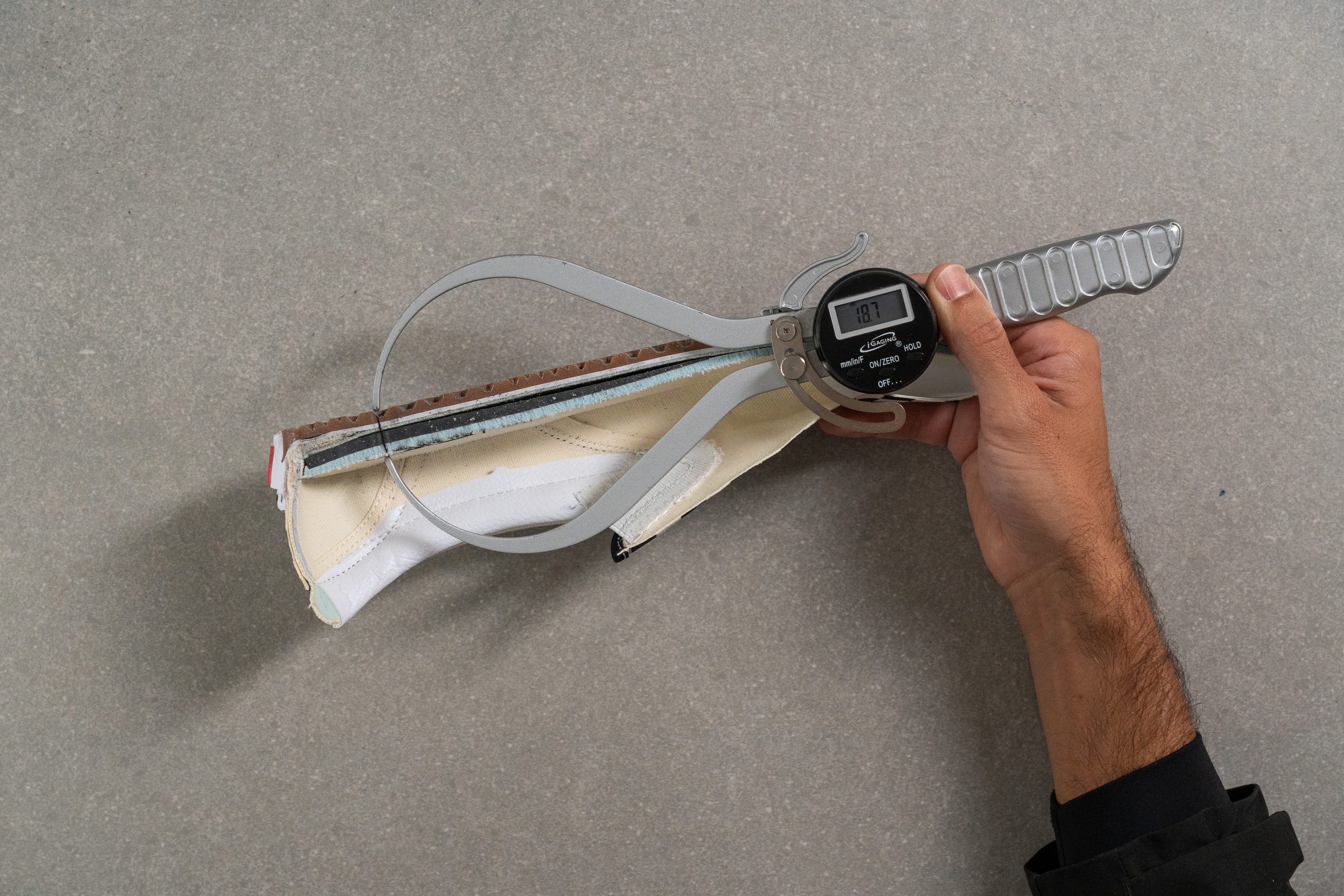
Having such a low profile gives us a very natural and intuitive sense of the ground below and makes walking around in this shoe feel like going barefoot while still having enough material underfoot for adequate impact dampening.
| Slip-On | 18.7 mm |
| Average | 30.7 mm |
Forefoot stack
Moving up to the forefoot, the Slip-On’s stack is only 12 mm thick, much shorter than our current lab average.
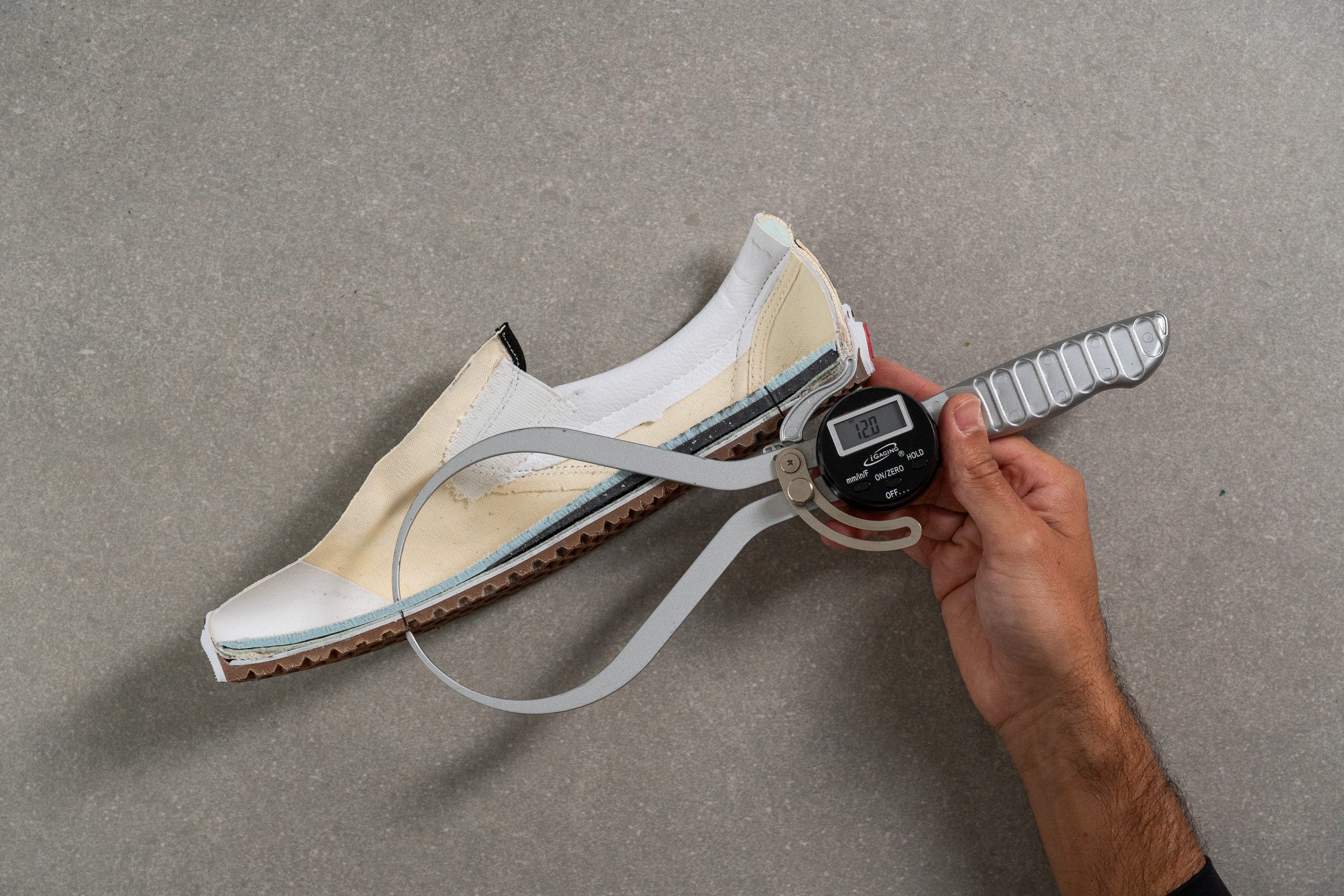
This further contributes to the shoe’s minimalist motif by keeping us low to the ground.
| Slip-On | 12.0 mm |
| Average | 19.5 mm |
Drop
The difference in our stack measurements leaves the Slip-On with a lower-than-average drop height of 6.7 mm.

This mild offset is quite versatile as it bridges the gap between those who prefer having an elevated heel and those who prefer a more parallel-to-the-ground experience.
| Slip-On | 6.7 mm |
| Average | 11.2 mm |
Size and fit
Size
Vans Slip-On fits true to size (4872 votes).
Width / Fit
Vans sneakers are notorious for having a snug and even narrow fit. However, we didn't experience any of that in the Vans Slip-On! As evidence, we used a custom gel to create a mold of the kick's internal space.
Once the gel solidified, we measured its dimensions with a digital caliper. The widest part of the mold (between the big toe and the pinkie) is a few solid millimeters wider than average, at 96.5 mm! That's pretty generous for a medium-width foot.
However, the shoe's limited instep volume can make people with wider feet struggle to put it on.

| Slip-On | 96.5 mm |
| Average | 92.5 mm |
Toebox width
There is no aggressive tapering in the Vans Slip-On either! As you can see, the sneaker has a rounded shape so there's no snugness that could be blamed on the pointy toebox.
Our caliper showed a standard width of 69.9 mm in the big toe area.
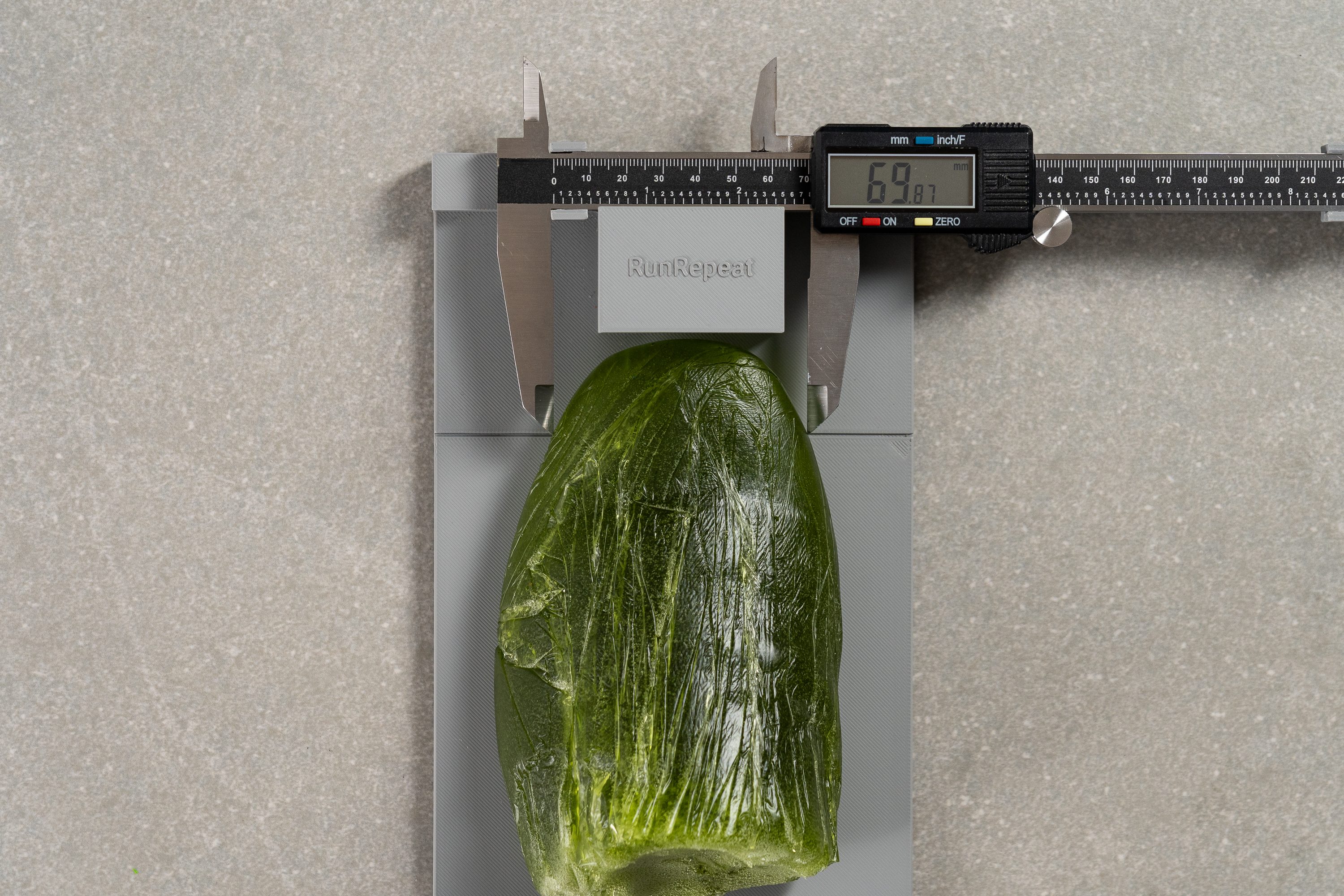
| Slip-On | 69.9 mm |
| Average | 68.9 mm |
Toebox height
So what is the problem? Looks like it's the shoe's low instep volume which also reflects in its lower-than-average toebox height of 26.0 mm.
Add the unforgiving canvas upper to the equation and you get the snug-fitting Vans Slip-On.
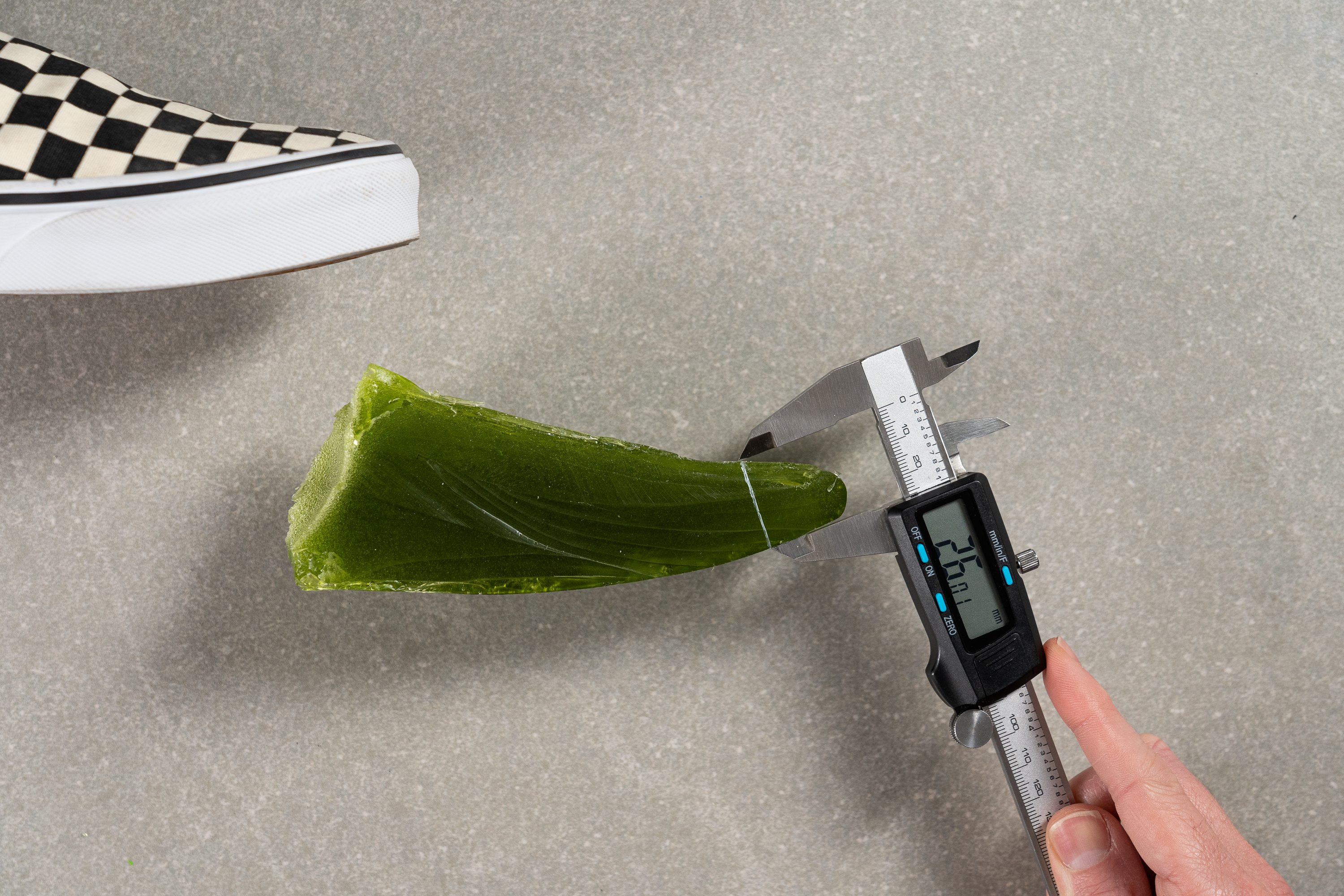
| Slip-On | 26.0 mm |
| Average | 27.8 mm |
Flexibility / Stiffness
The Slip-On is more flexible than the average sneaker, requiring only 10.7N of force to bend it to 90 degrees when secured to our workbench.
This level of flexibility contributes greatly to the comfy and forgiving nature of this shoe which pleasingly adapts to the natural movement of our foot during our stride.
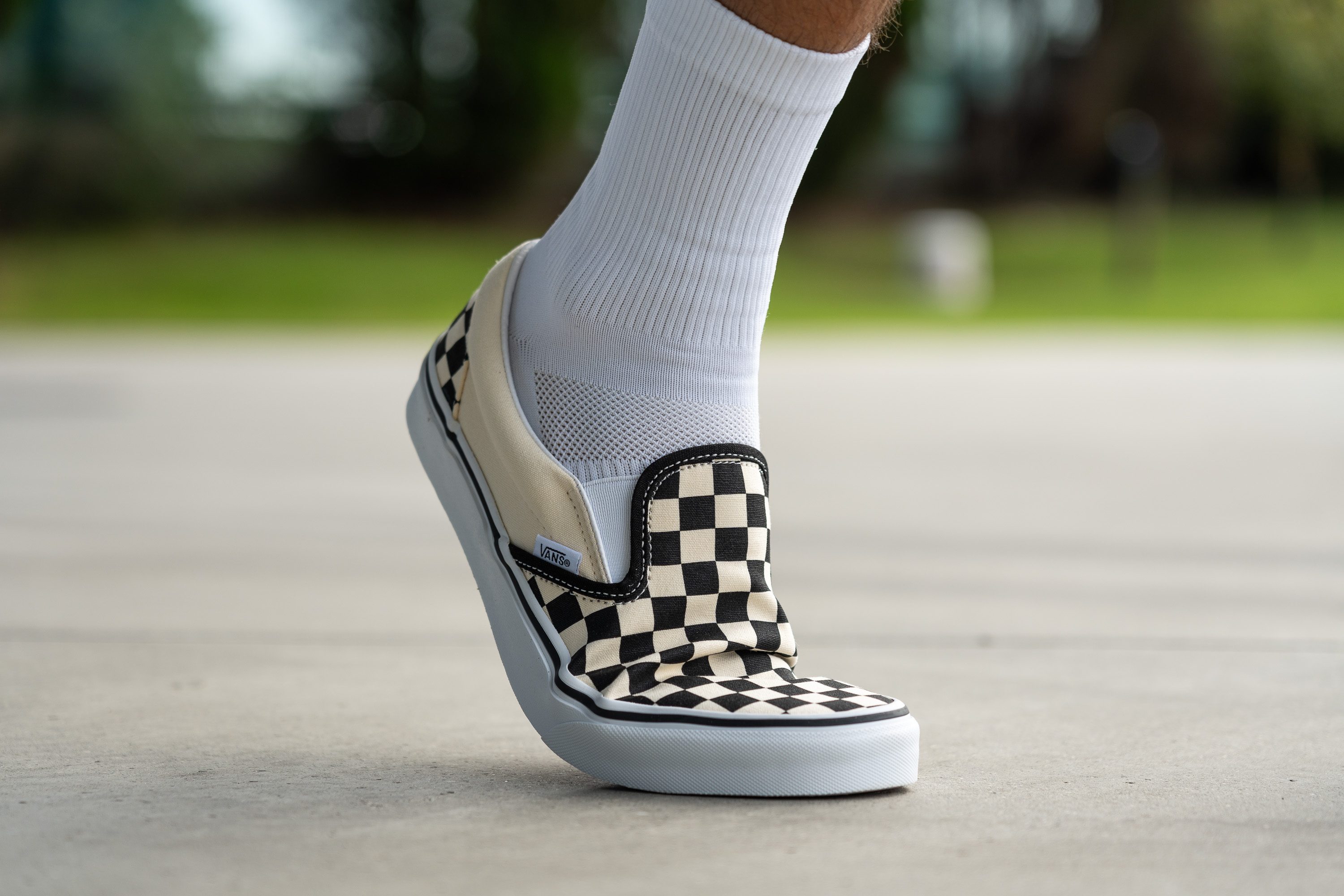
This test follows an older methodology, which is why you don't see recently tested shoes in the chart. Results from different methodologies can not be compared.
| Slip-On | 10.7N |
| Average | 23.3N |
Weight
Tipping the scale at 14.1 oz (400g), the Slip-On weighs about as much as the average sneaker.
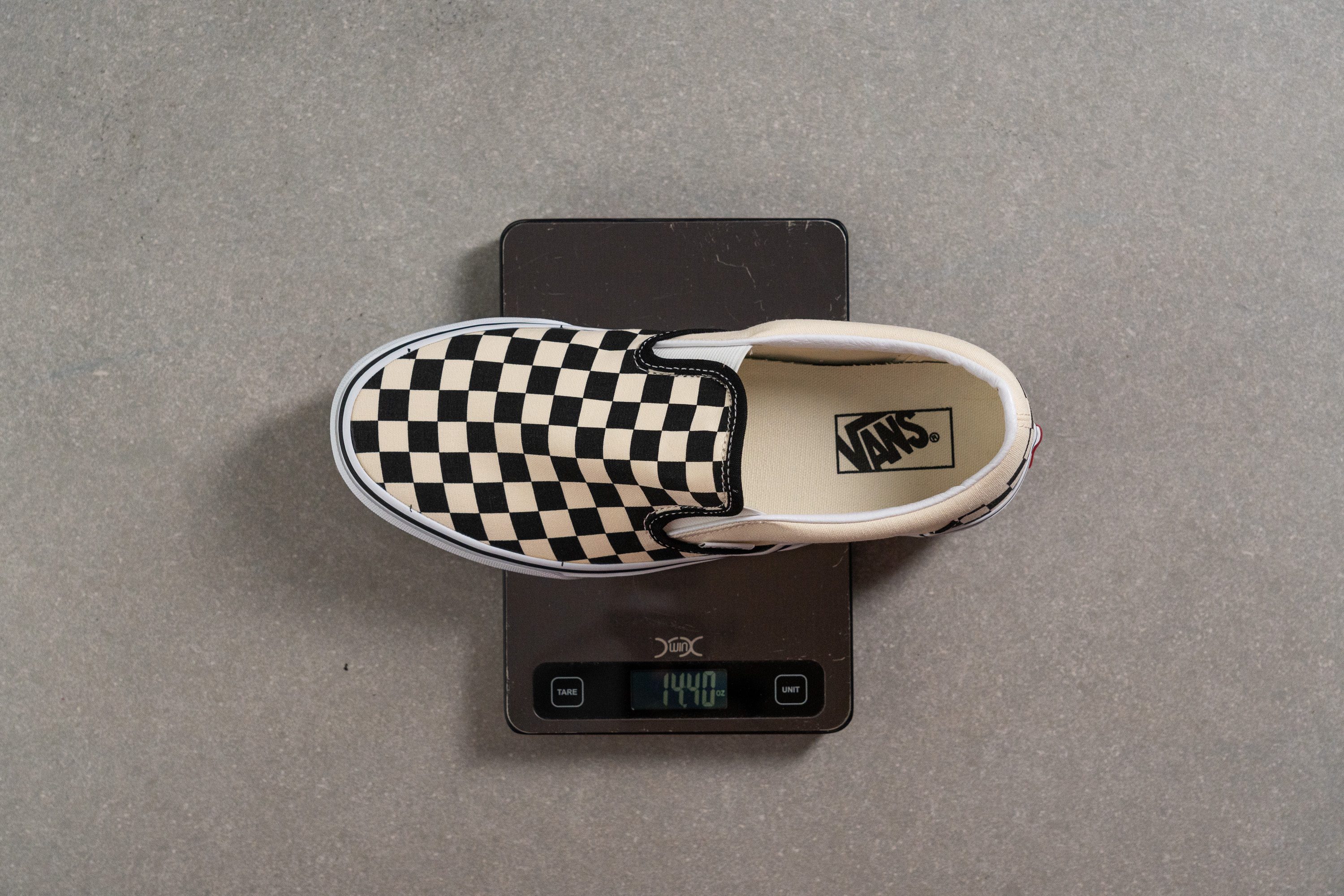
| Slip-On | 14.1 oz (400g) |
| Average | 13.8 oz (390g) |
Breathability
Not even a wisp of smoke was able to escape the shoe’s well-fortified canvas upper throughout our twenty-second smoke test, earning it a sub-standard breathability score of 1 out of 5. This lack of ventilation does mean that going sockless is likely to result in stinky feet/shoes.
As we can see from looking at a cross-section of the Slip-On over a backlight, very little light is able to penetrate the dense canvas upper.
Inspecting the shoe’s upper under our microscope, it’s clear to see that the canvas is woven with the tight precision of a machine-made carpet. With almost no space between the interlocked strands, the mystery of the upper’s lackluster airflow can be put to rest.
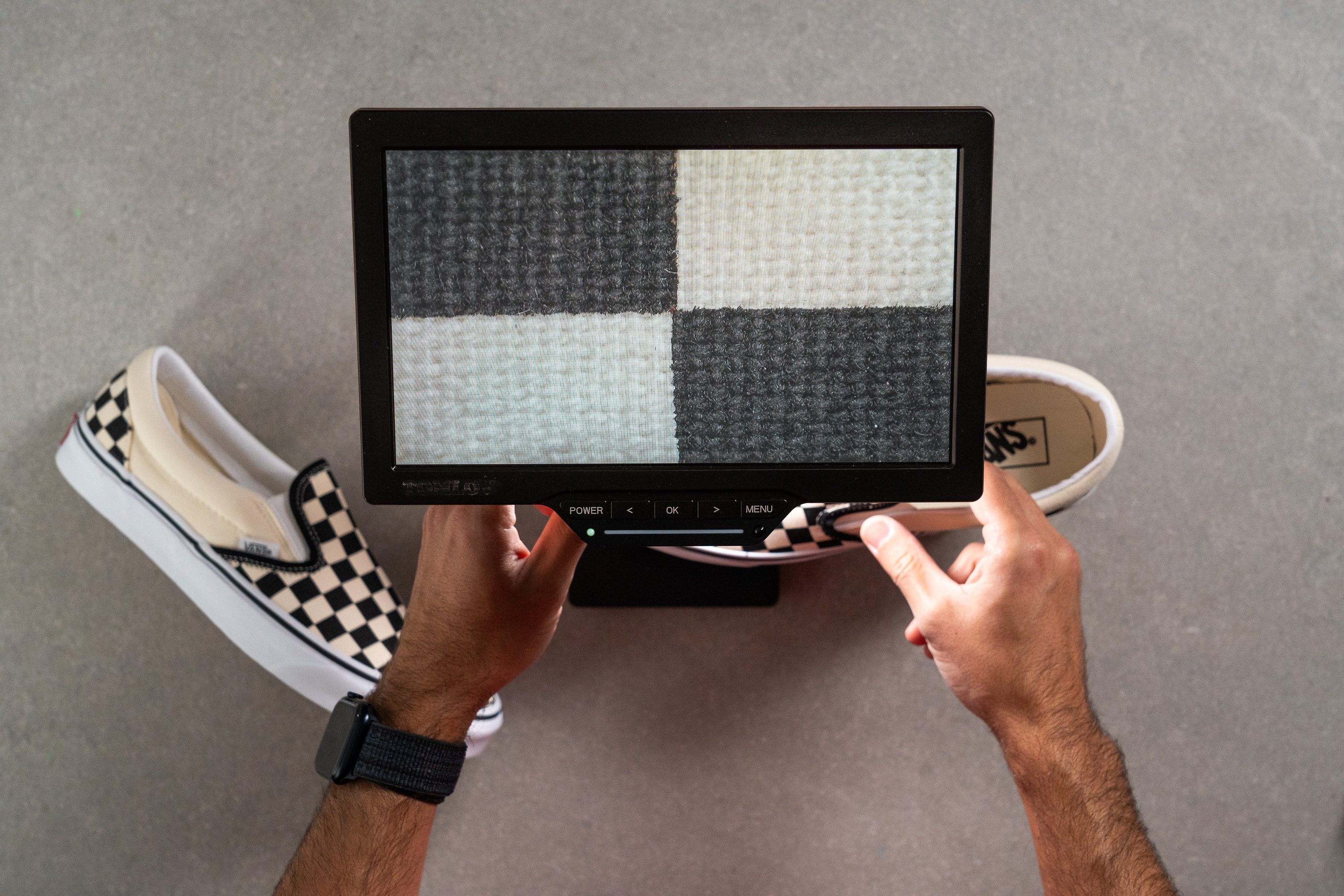
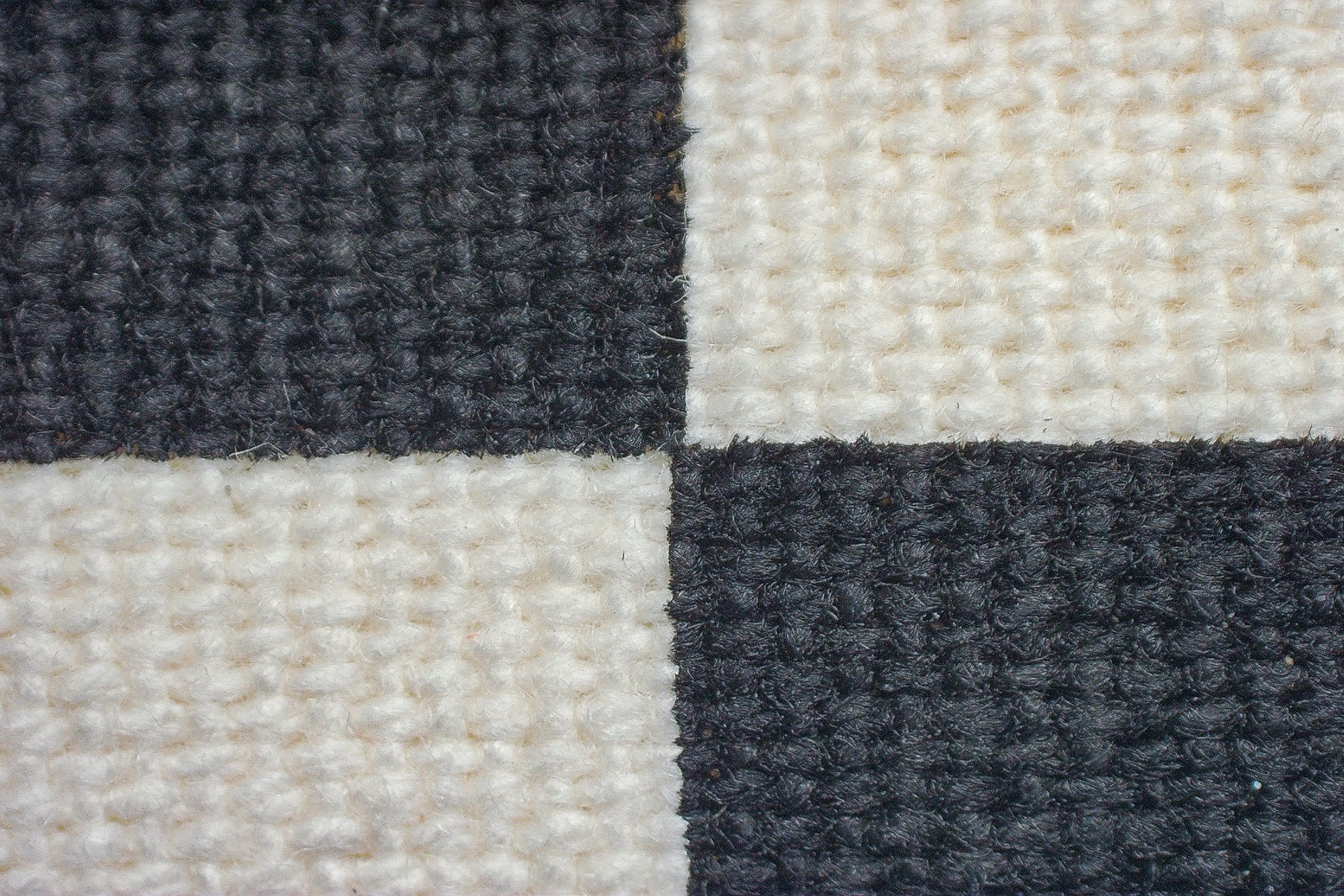
On the other hand (or foot) it would be safe to assume that this insular nature makes the shoe a good option for winter wear, given they’re used in tandem with a warm pair of cozy socks.
| Slip-On | 1 |
| Average | 3 |
Stability
Lateral stability test
With such a low-profile shoe, it’s no wonder that the Slip-On feels so incredibly well-planted as we shift our weight from side to side.
Torsional rigidity
The Slip-On put up almost no resistance as we bent and twisted it in our hands, earning the shoe a torsional rigidity score of 1 out of 5. As such, the shoe feels extremely comfy as it puts up no resistance to the natural movements of our foot during our stride.
| Slip-On | 1 |
| Average | 3.6 |
Heel counter stiffness
The Slip-On's heel counter is also extremely pliable, earning another 1 out of 5 in our manual assessment. This gives us an extremely unrestricted feeling at the heel as the shoe loosely holds our foot in place, making it feel quite easy on our tendons. On the other hand, this means that a swift kick can easily launch the shoe off and send it sailing through the air as it doesn't provide the most secure lockdown.
| Slip-On | 1 |
| Average | 3.2 |
Midsole width - forefoot
According to our caliper measurements, the Slip-On’s midsole is 103.1 mm wide at the forefoot. This isn't quite as wide as our current lab average but didn’t negatively affect how stable we felt in the shoe.
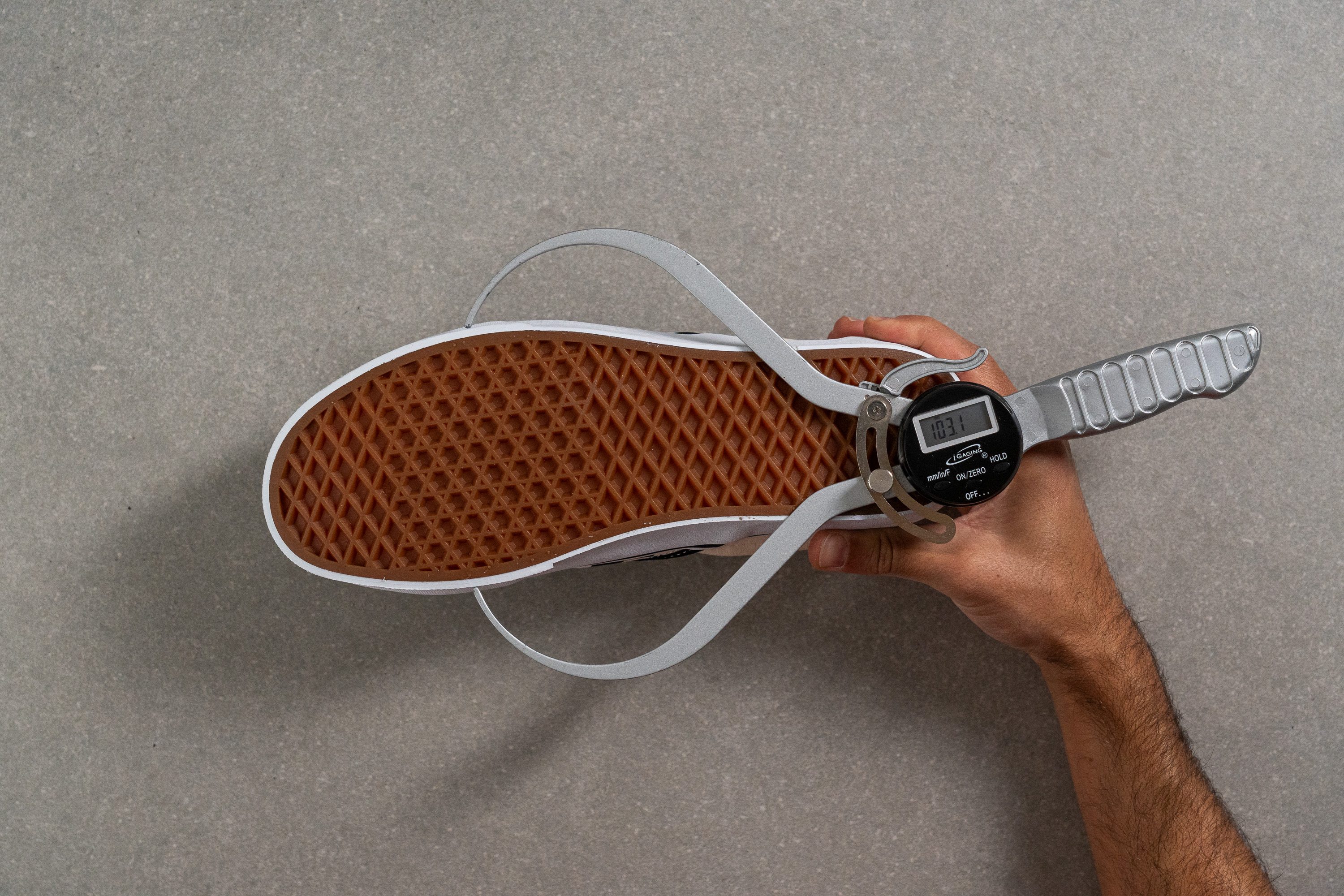
| Slip-On | 103.1 mm |
| Average | 108.9 mm |
Midsole width - heel
Back at the heel, we found the Slip-On's midsole to be significantly narrower than average at only 71.8 mm thick. This, again, didn't present us with any problems while going about our day-to-day activities, and will only be an issue for those used to shoes with a more robust platform like the New Balance 574.
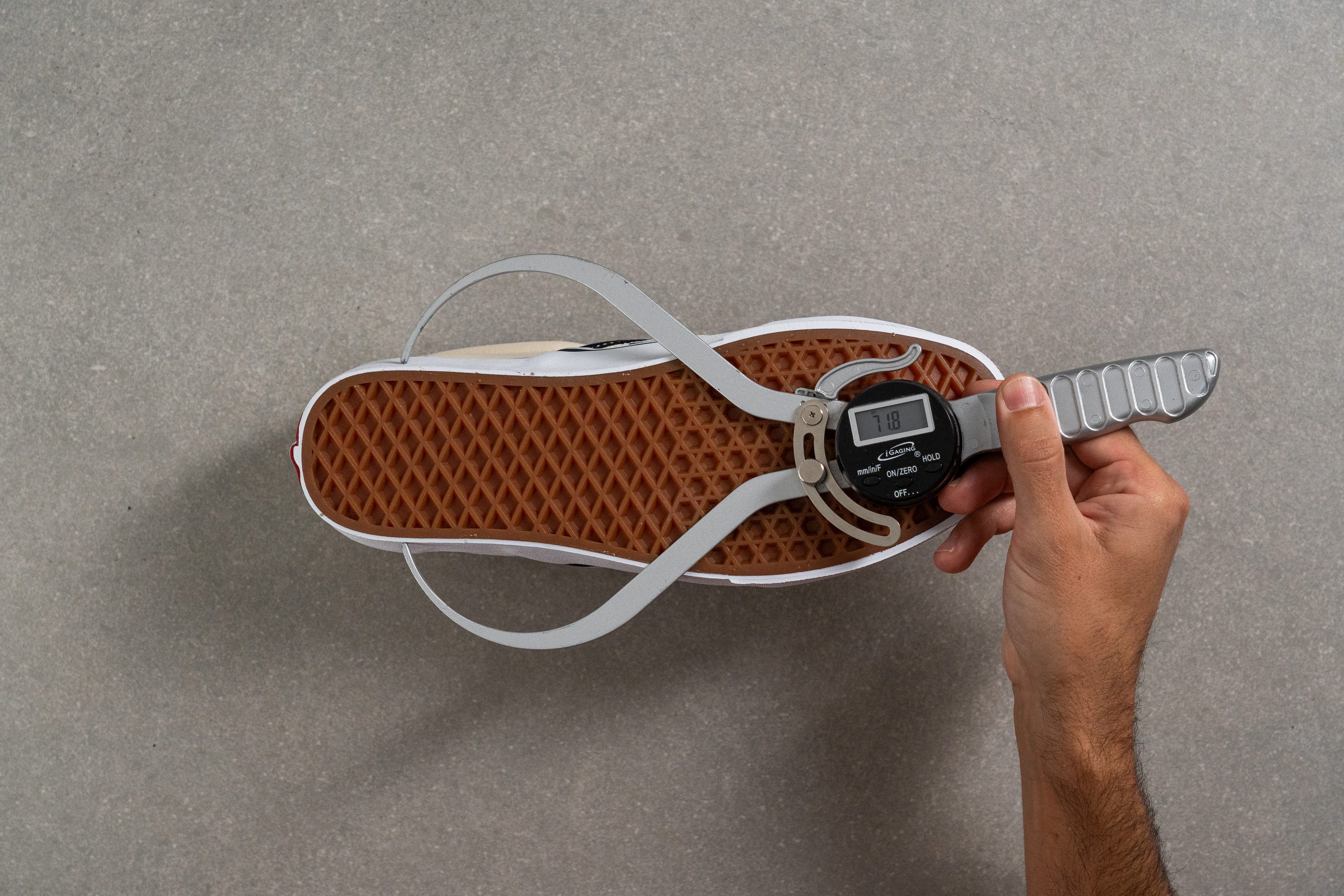
| Slip-On | 71.8 mm |
| Average | 84.0 mm |
Durability
Leather/Suede quality
We torched the lining of the heel collar to see if it's made of genuine leather. Things look good at first as it doesn't melt under the flame, though the way it chips away as we scratch it with our awl makes it clear that it's actually synthetic.
| Slip-On | Fake leather |
Toebox durability
First up to face the Dremel in our battery of durability tests is the toebox. With the abrasive element rotating at 5K RPM, we applied the tool to the shoe with 3.2N of force which immediately sent shreds of canvas flying around.
However, upon assessing the aftermath of the four-second test, we found that we hadn’t inflicted as much damage as we had anticipated. The tool didn’t even pierce through the toebox at all, leaving it a little worse for wear but overall fairly intact. This leads us to give the Slip-On a respectable toebox durability score of 3 out of 5. That teaches us to question the hardiness of a skateboarding shoe.
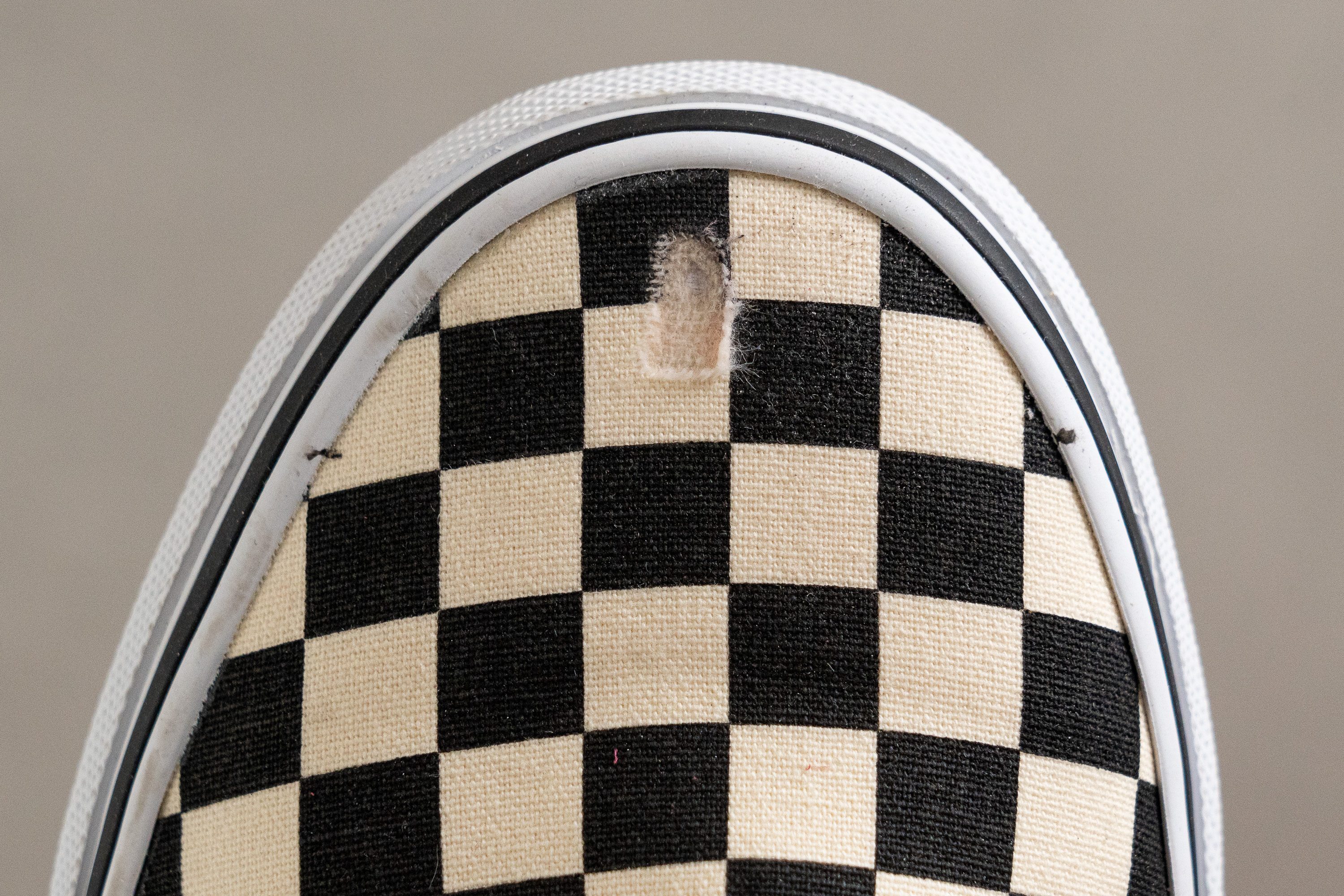
| Slip-On | 3 |
| Average | 3.7 |
Heel padding durability
Next, we turned our attention to the heel counter and put our Dremel to work again.
Four seconds of abrasive force was all the tool needed to mince through the leatherette lining and begin eating at the soft padding within. However, with much of the scant padding remaining relatively unscathed, we give the Slip-On a heel padding durability score of 3 out of 5.
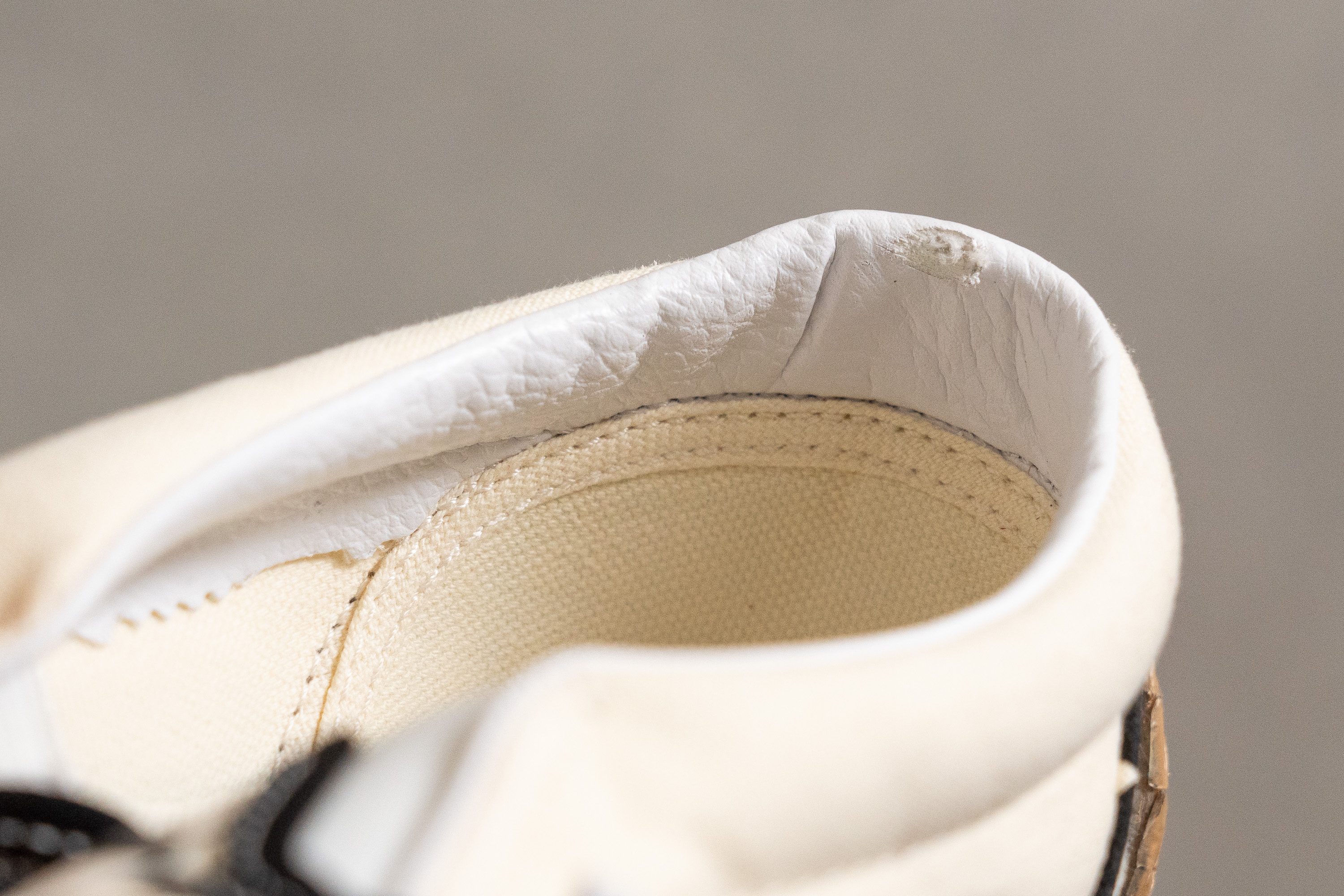
| Slip-On | 3 |
| Average | 3.2 |
Outsole hardness
Pressing our durometer against the Slip-On’s outsole gives us a reading of 83.3 HC. This is right on par with our current lab average which usually denotes a healthy mix of grip and durability,
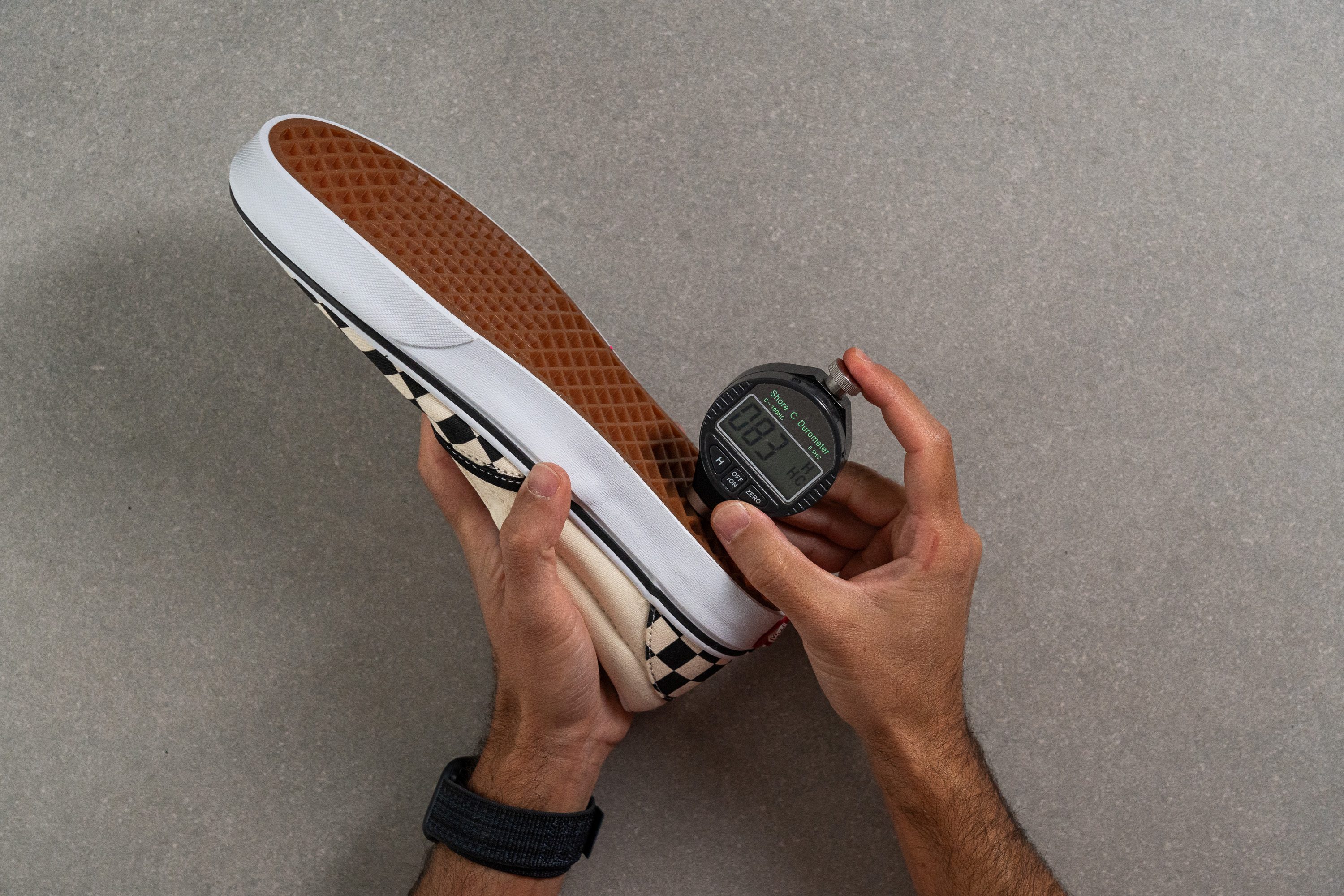
| Slip-On | 83.3 HC |
| Average | 85.7 HC |
Outsole durability
Last to face the chopping block and contend with our Dremel is the Slip-On’s outsole. This time spinning at 10K RPM, the tool’s grinding element eased its way through the outsole rubber like a hot knife through butter.
Once the twenty-second test was up, we used a tire tread gauge to assess the damage and found that we had lopped off 1.65 mm of material. This is more than the average sneaker loses in this same test, making the Slip-On’s outsole less durable than expected. As such, we expect this shoe to start showing signs of wear and tear within 400 miles of normal use. This will be exacerbated by abrasive activities like skateboarding which will likely negatively impact the shoe’s longevity.

| Slip-On | 1.6 mm |
| Average | 1.1 mm |
Outsole thickness
Using our claiper, we measured the Slip-On’s outsole to be 5.5 mm thick which is right on par with our current lab average.
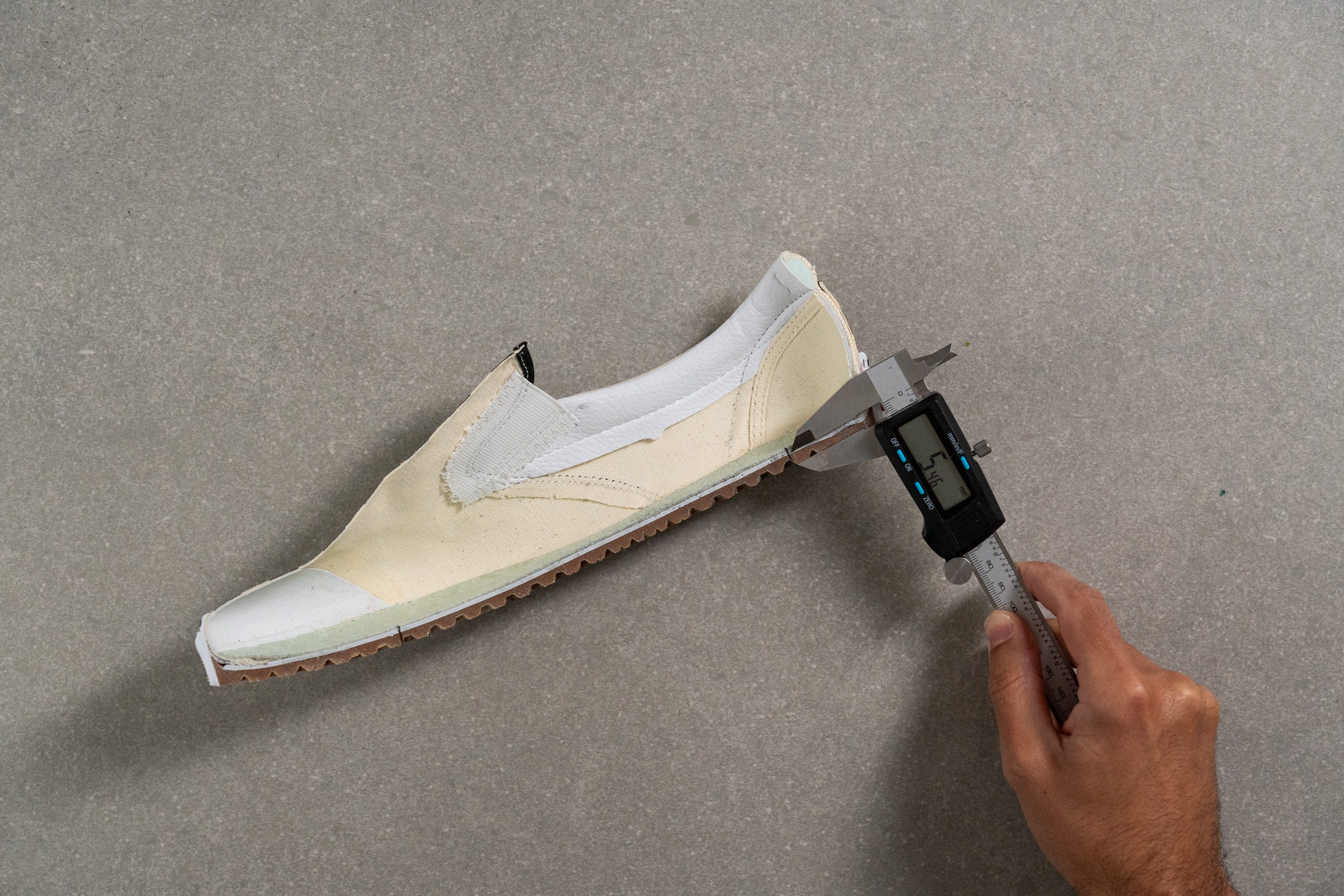
| Slip-On | 5.5 mm |
| Average | 5.3 mm |
Misc
Insole thickness
The Slip-On’s insole is thicker than average at 8.6 mm according to our caliper measurements. This gives us an incredibly soft platform within the shoe that serves to soften our landings in lieu of a foam midsole.
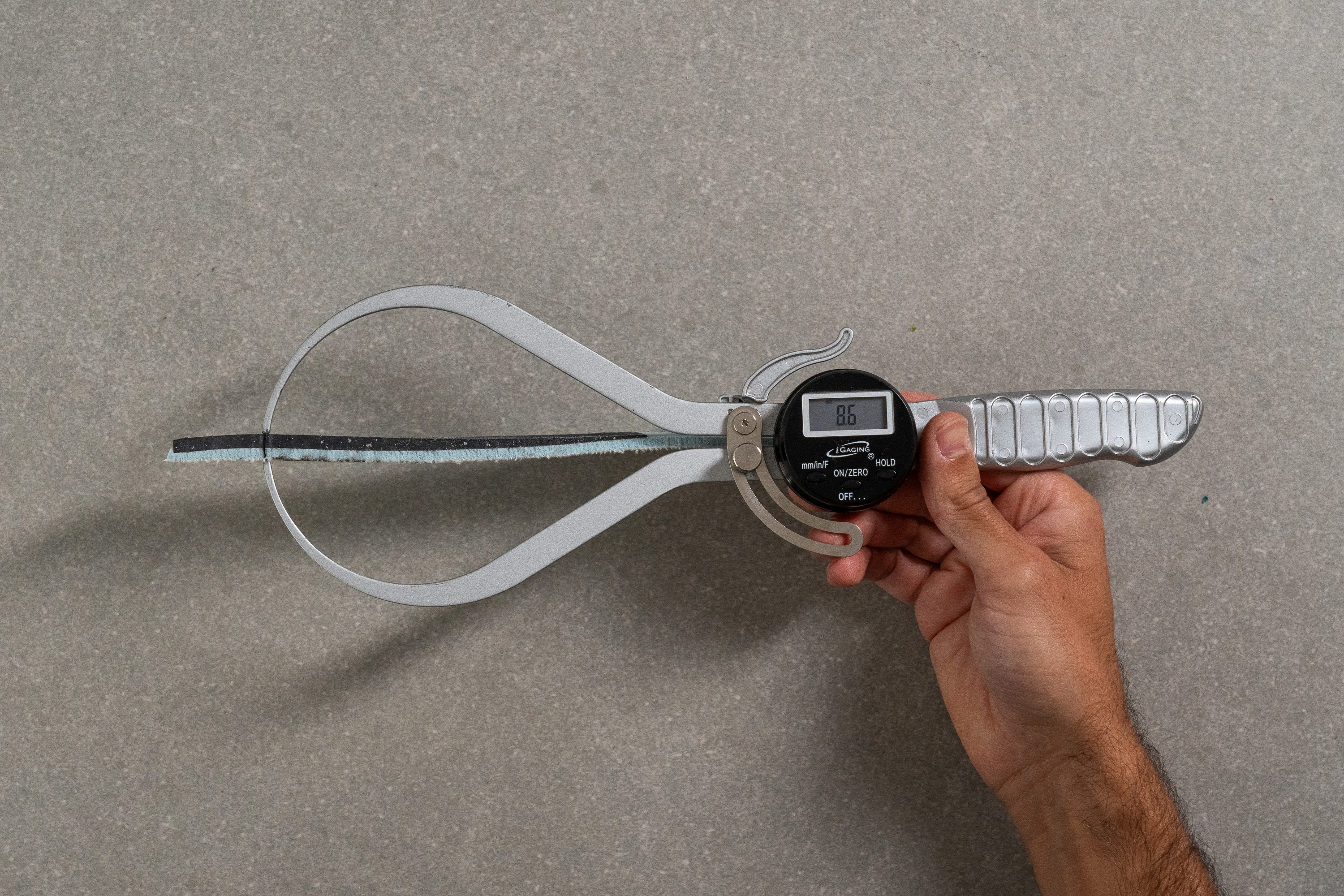
| Slip-On | 3.6 mm |
| Average | 5.1 mm |
Removable insole
The glued insole means that the Slip-On isn't receptive to custom orthotics.
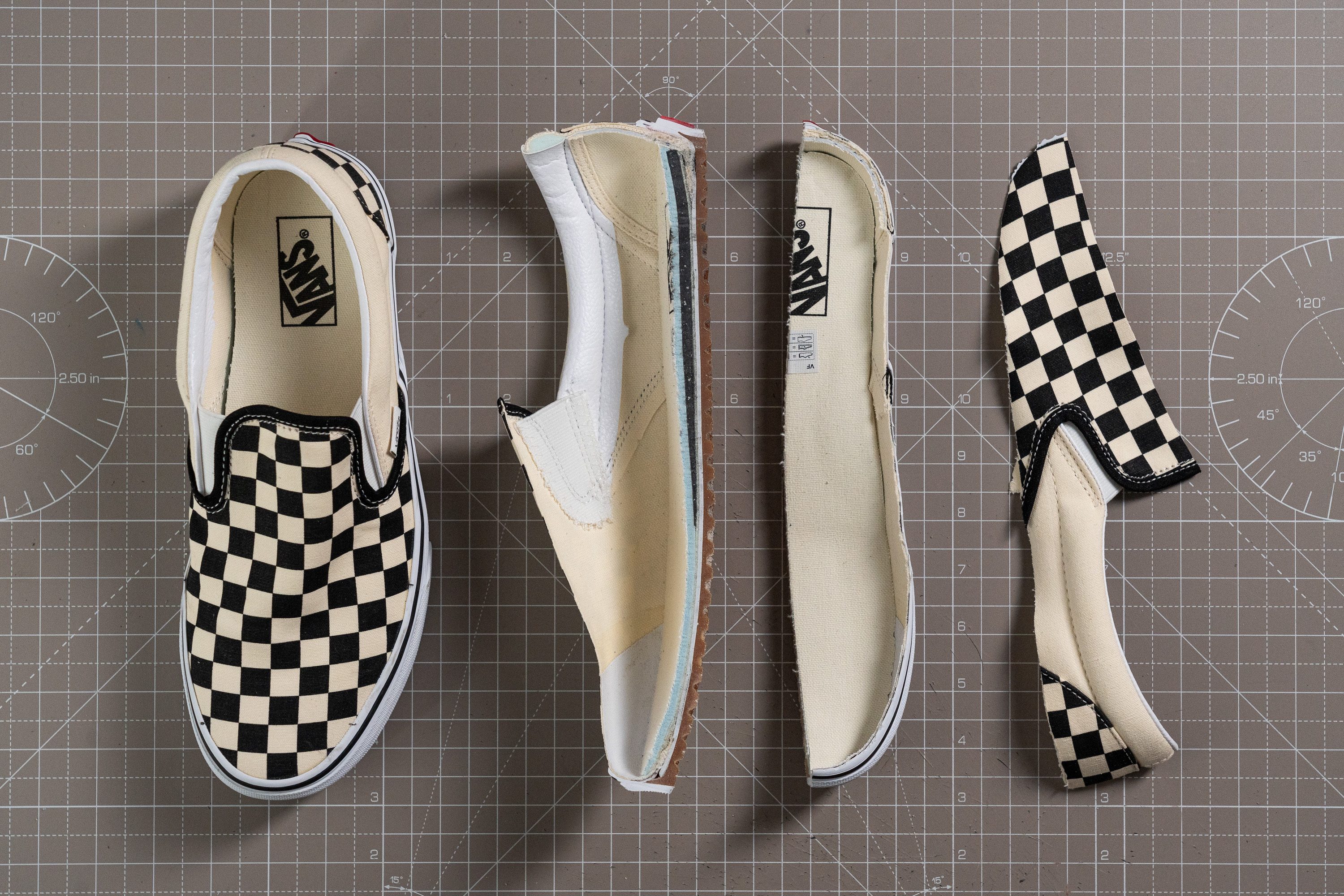
| Slip-On | No |
Reflective elements
The Slip-On doesn't feature any reflective elements.

| Slip-On | No |
Tongue padding
Since the Slip-On doesn’t feature a tongue per se, we measured the part of the upper above the instep and found it to be 1 mm thick according to our caliper. This is much less material around the instep than found in most shoes which certainly has a negative effect on the shoe’s foothold.
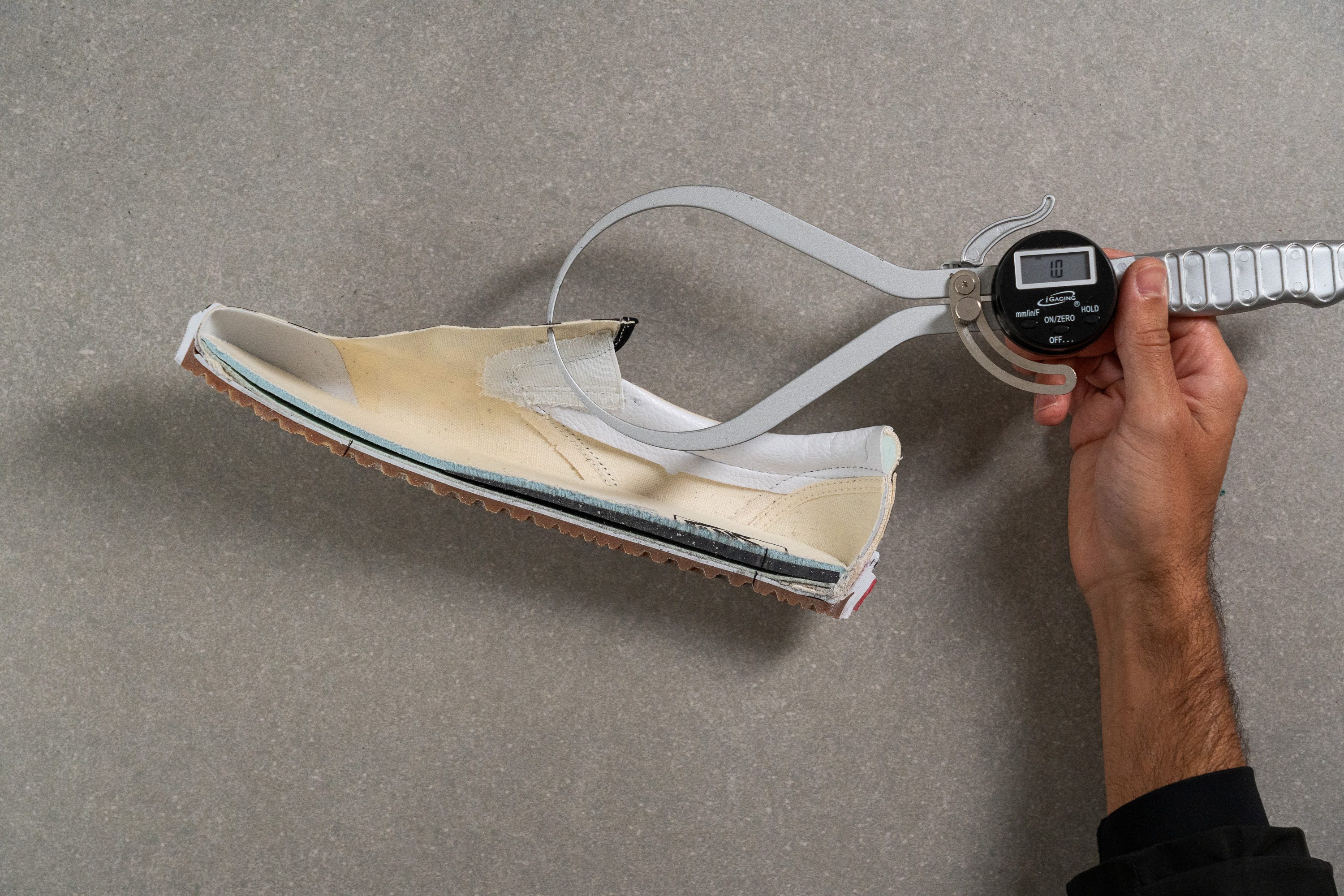
| Slip-On | 1.0 mm |
| Average | 9.6 mm |
Tongue: gusset type
The Slip-On has a sock-like fit facilitated by the two elastic strips on either end of the instep. These stretch out easily which allows us to slide the shoe on with ease and tense back up to provide a somewhat secure lockdown.
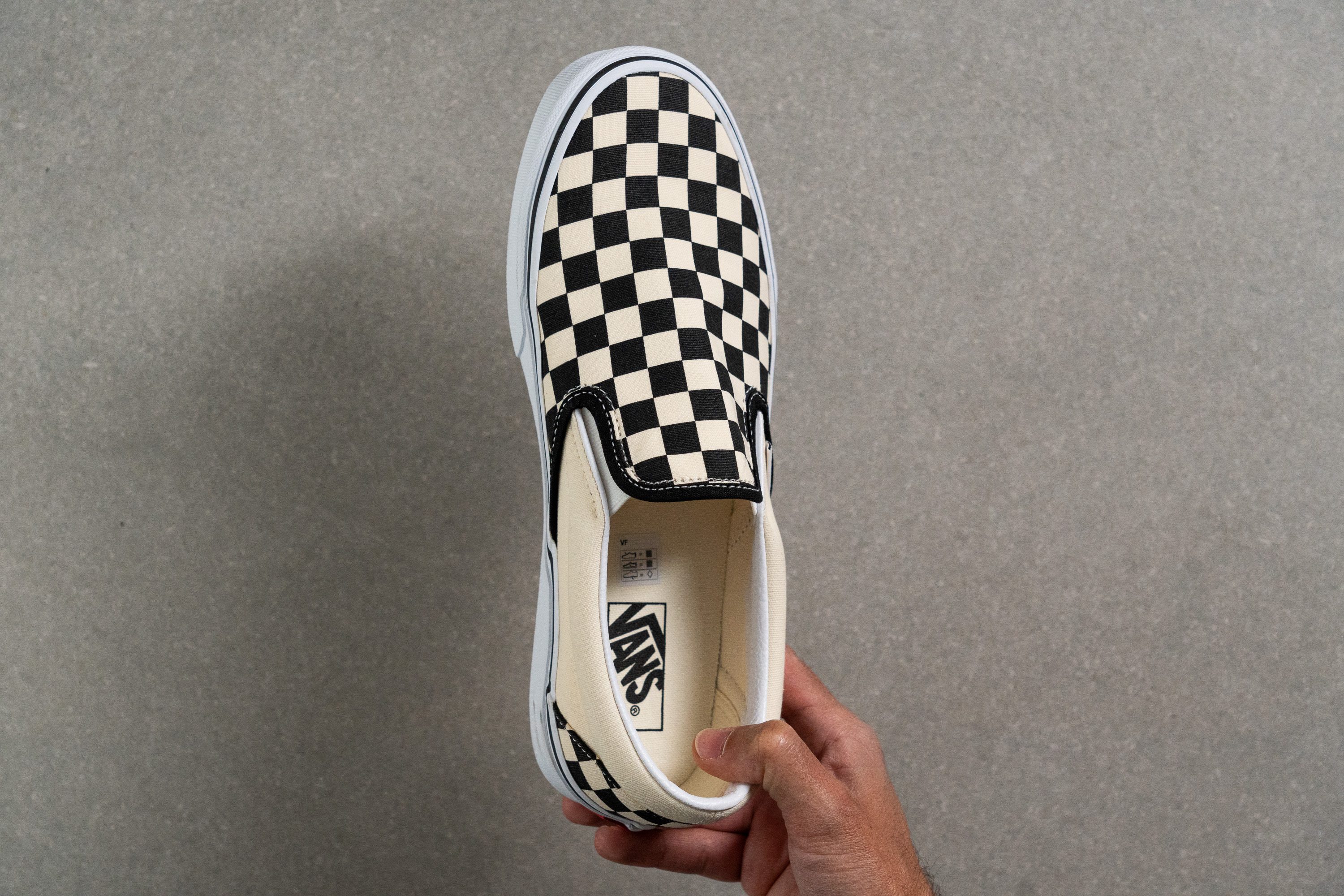
While this holds the foot in place enough for day-to-day goings on, it doesn’t do well with more intense activities like running where the shoe feels like it’s going to go flying off with every stride.
| Slip-On | Sock like |

